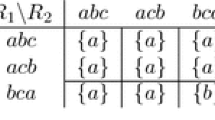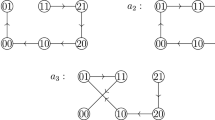Abstract
We consider a self-administered organization characterized by a principal elected by the agents of the organization. Conditions are established under which self-administration leads to either stronger or weaker incentives in comparison to an organization which only pursues exogenous objectives. While the output of the organization is controlled by the effort of the agents and by nature, the pay-off of the principal also includes rents from office. Generally, two different contractual regimes can be observed: either a hard regime with strong incentives and low fixed payments, or a soft regime with weak incentives and high fixed payments.
Similar content being viewed by others
References
Austen-Smith, D., & Banks, J. (1989). Electoral accountability and incumbency. In P. Ordeshook (Ed.), Models of strategic choice in politics. Ann Arbor: University of Michigan Press.
Banks, J., & Sundaram, R. (1993). Moral hazard and adverse selection in a model of repeated elections. In W. Barnett (Eds.), Political economy. Cambridge: Cambridge University Press.
Banks, J., & Sundaram, R. (1998). Optimal retention in agency problems. Journal of Economic Theory, 82, 293–323.
Barro, R. (1973). The control of politicians: an economic model. Public Choice, 14(1), 19–42.
Besley, T., & Ghatak, M. (2005). Competition and incentives with motivated agents. American Economic Review, 95(3), 616–636.
Canton, E. (2005). Power of incentives in public organizations when employees are intrinsically motivated. Journal of Institutional and Theoretical Economics, 161(4), 664–680.
Coughlin, P. (1982). Probabilistic voting theory. Cambridge: Cambridge University Press.
Dewatripont, M., Jewitt, I., & Tirole, J. (1999). The economics of career concerns, part II: application to missions and accountability of government agencies. Review of Economic Studies, 66(1), 199–217.
Dixit, A. (2002). Incentives and organizations in the public sector: an interpretative review. Journal of Human Resources, 37(4), 696–727.
Ferejohn, J. (1986). Incumbent performance and electoral control. Public Choice, 50, 5–25.
Holmström, B. (1979). Moral hazard and observability. Bell Journal of Economics, 10, 74–91.
Niskanen, W. A. (1971). Bureaucracy and representative government. Chicago: Aldine Atherton.
Reed, W. R. (1994). A retrospective voting model with heterogeneous politicians. Economics and Politics, 6(1), 39–58.
Rogoff, K. (1990). Equilibrium political budget cycles. American Economic Review, 80(1), 21–36.
Romer, T., & Rosenthal, H. (1979). Bureaucrats vs. voters: on the political economy of resource allocation by direct democracy. Quarterly Journal of Economics, 93(4), 563–587.
Shiozawa, Y. (2004). Evolutionary economics in the 21st century: a manifesto. Evolutionary and Institutional Economics Review, 1(1), 5–47.
Author information
Authors and Affiliations
Corresponding author
Rights and permissions
About this article
Cite this article
Dehm, R., Wigger, B.U. A principal-agent approach to a self-administered organization with an elected principal. Public Choice 140, 421–429 (2009). https://doi.org/10.1007/s11127-009-9428-9
Received:
Accepted:
Published:
Issue Date:
DOI: https://doi.org/10.1007/s11127-009-9428-9




